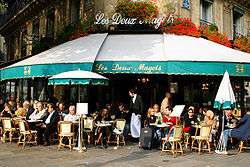Les Deux Magots
Les Deux Magots (French pronunciation: [le dø maɡo]) is a famous[1] café in the Saint-Germain-des-Prés area of Paris, France. It once had a reputation as the rendezvous of the literary and intellectual élite of the city. It is now a popular tourist destination. Its historical reputation is derived from the patronage of Surrealist artists, intellectuals such as Simone de Beauvoir and Jean-Paul Sartre, and young writers, such as Ernest Hemingway. Other patrons included Albert Camus, Pablo Picasso, James Joyce, Bertolt Brecht, Julia Child, and the American writers James Baldwin, Chester Himes and Richard Wright.[2]

The Deux Magots literary prize has been awarded to a French novel every year since 1933.
Origin of the name
"Magot" literally means "stocky figurine from the Far East".[3] The name originally belonged to a fabric and novelty shop at nearby 23 Rue de Buci. The shop sold silk lingerie and took its name from a popular play of the moment (1800s) entitled Les Deux Magots de la Chine. Its two statues represent Chinese "mandarins", or "magicians" (and "alchemists", depending upon one's philosophical point of view), who gaze serenely over the room. In 1873, the business moved to its current location in the Place Saint-Germain-des-Prés. In 1884, the business changed to a café and liquoriste, keeping the name.
Auguste Boulay bought the business in 1914, when it was on the brink of bankruptcy, for 400,000 francs. The present manager, Catherine Mathivat, is his great-great-granddaughter.
References in literature and popular culture
In literature
- Les Deux Magots appears in The Chariot Makers (by Steve Matchett), in which the author describes Les Deux Magots as: "the first café in the quarter to be blessed by the morning sun. Its clientele pay a healthy premium for drinking there, it’s only fitting they should be the first to catch the warmth of the new day."
- The Café is mentioned in Georges Bataille's 1928 novella Story of the Eye.
- The café figures prominently in Abha Dawesar's novel That Summer in Paris (2006).
- The café is referenced in the 1955 novel Lolita by Vladimir Nabokov. The narrator claims, "I sat with uranists in the Deux Magots."
- The café is the setting for a pivotal scene in the 1998 novel The Magic Circle by Katherine Neville. The novel was displayed for several months in the windows of Les Deux Magots.[4]
- The café is mentioned in Pete Hamill's 2011 novel, Tabloid City.
- The café is mentioned in Craig Ferguson's 2006 novel, Between the Bridge and the River.
- It receives a mention in the Nobel Laureate Mario Vargas Llosa's novel The Bad Girl (2006).
- In the 2009 novel El hombre que amaba a los perros (The Man who Loved Dogs) by Leonardo Padura it is one of the places where Trotsky's assassin, Ramon Mercader, spends time while waiting to be sent to Mexico to complete his assignment.
- The café features prominently in Marco Missiroli's Atti osceni in luogo privato book about the young life of Libero Marsell, whose father will be a patron of the cafè and will befriend writer Albert Camus before the author's death.
- The café is mentioned in Jean Rhys's 1938 novel, Good Morning, Midnight.
- The café is referenced in Charlton Pettus' novel, Exit Strategy (2018).
- The café is the site of an important event in China Miéville's novella The Last Days of New Paris (2016).
- The cafe is mentioned in the early paragraphs of Gavin Lyall's 1965 novel Midnight Plus One.
- The cafe is mentioned in chapter 13 of Blood is Blood (2018), the tenth novel in the Barker and Llewelyn series by Will Thomas.
In graphic novels
- The café is seen in the 4th part of the manga series JoJo's Bizarre Adventure.
In art
- 1959 color photograph by Saul Leiter.
- 1967 figurative painting by Jean-François Debord.[5]
In film
- Several scenes in the 1949 movie The Man on the Eiffel Tower take place here.
- The café features in the 1959 film The Sign of Leo by Eric Rohmer.
- The café appears in the 1973 film The Mother and the Whore, directed by Jean Eustache.
- The café appears in an early scene of the 1973 film The Mad Adventures of Rabbi Jacob[6], directed by Gérard Oury, in which the fictional Arab revolutionary leader, Mohamed Larbi Slimane (Claude Giraud) is kidnapped, echoing the 1965 kidnapping of Mehdi Ben Barka in front of nearby Café Lipp.
- The café features in a scene in the 2012 film Intouchables, in a scene in which Philippe (François Cluzet) is waiting to meet his "blind date" for lunch. directed by Olivier Nakache and Éric Toledano'
In television
- The café features in a scene in the final episode of NBC sitcom The Good Place.
Footnotes
- Bidding goodbye to the Gauloises
- Historical cafes in Paris: Les Deux Magots Archived 22 March 2013 at the Wayback Machine
- Journal Notre 6ème n°237, November 2010, page 10
- "The Magic Circle". Katherine Neville.
- fr:Jean-François Debord
- https://www.imdb.com/title/tt0069747/locations
External links
| Wikimedia Commons has media related to Les Deux Magots. |